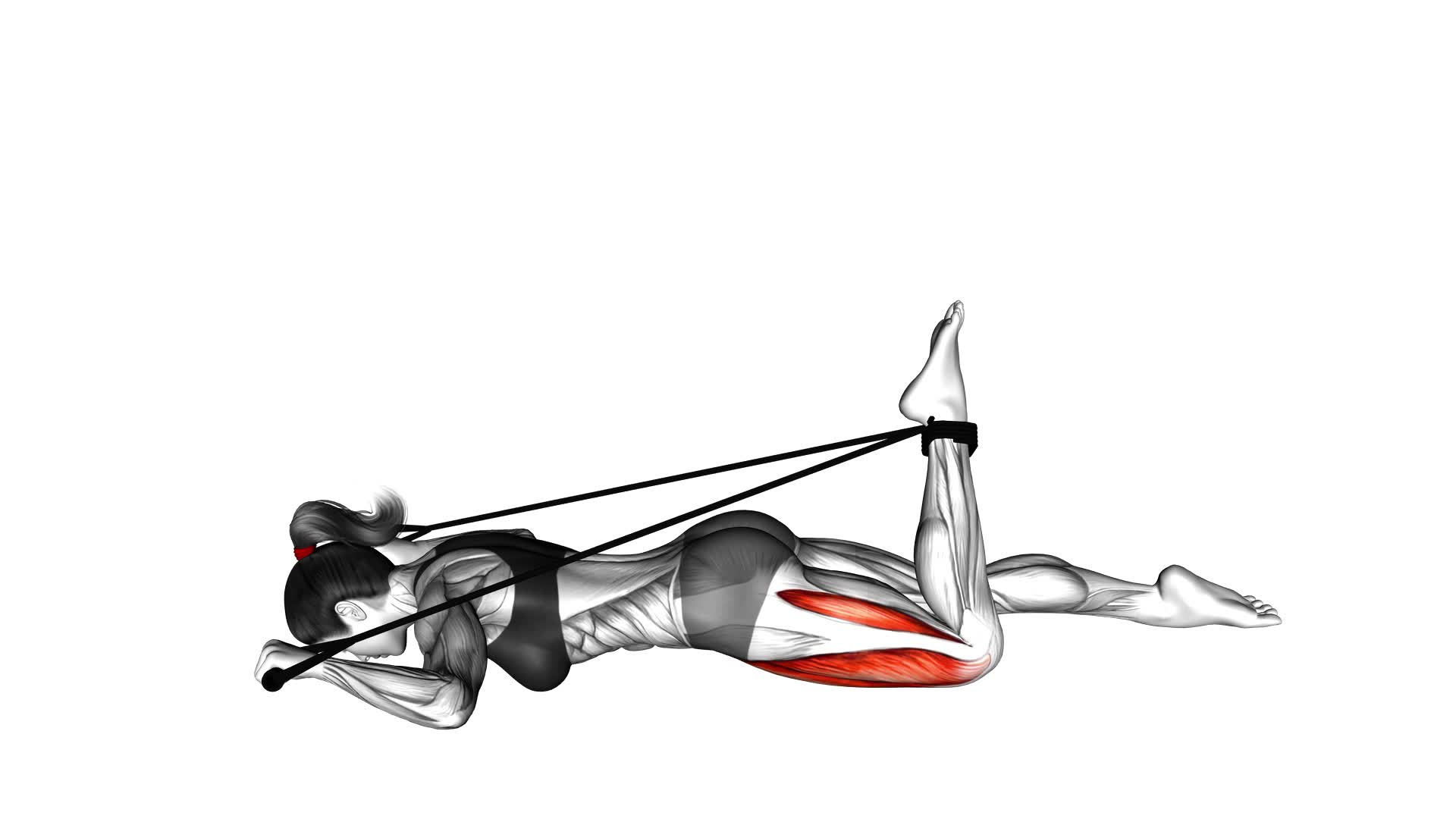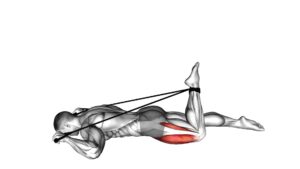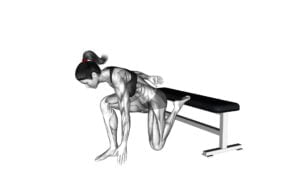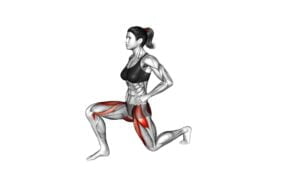Intermediate Hip Flexor and Quad Stretch (female) – Video Exercise Guide & Tips

Get ready to take your hip flexor and quad stretch to the next level! In this intermediate video exercise guide, we'll show you the proper form and technique to effectively stretch these muscle groups.
Watch This Exercise Video
Plus, we've got some valuable tips for increasing flexibility and avoiding common mistakes. Whether you're a beginner or more advanced, this routine will help you improve your flexibility and prevent injury.
So grab your mat and let's get stretching!
Key Takeaways
- The hip flexor and quad stretch can increase mobility in hip flexors and quadriceps muscles.
- It can improve range of motion and flexibility.
- Regularly performing this stretch can prevent injuries caused by tightness or imbalances.
- It can alleviate lower back pain, improve posture, and reduce knee pain while improving mobility.
Benefits of the Hip Flexor and Quad Stretch
By performing the intermediate hip flexor and quad stretch, you can experience several benefits. This stretch is a great way to increase mobility in your hip flexors and quadriceps muscles. It helps to improve the range of motion in these areas, allowing for better flexibility and movement. By regularly stretching these muscles, you can prevent injuries that may occur from tightness or imbalances.
Tight hip flexors can lead to lower back pain and poor posture, while tight quads can cause knee pain and limited mobility. Stretching these muscles can help to alleviate these issues and keep your body functioning properly.
In addition to increasing mobility and preventing injuries, the hip flexor and quad stretch also helps to improve your overall athletic performance. By maintaining flexibility in these areas, you can move more efficiently and effectively during physical activities. This can enhance your speed, agility, and power, making you a better athlete. Whether you're a runner, a dancer, or just someone who wants to stay active and injury-free, incorporating the intermediate hip flexor and quad stretch into your routine is a smart choice.
Proper Form and Technique
To ensure proper form and technique during the intermediate hip flexor and quad stretch, there are a few key points to keep in mind.
First, focus on maintaining alignment throughout the exercise, making sure your body stays in a straight line from head to toe.
Additionally, be mindful of common mistakes such as arching your back or lifting your shoulders, and make adjustments as needed to avoid these errors.
Alignment Tips for Stretches
Maintain proper alignment during stretches by positioning your body correctly. Here are some alignment tips to help you get the most out of your stretches:
- Keep your spine neutral: Avoid arching or rounding your back, as this can put unnecessary strain on your spine.
- Engage your core: By activating your core muscles, you can stabilize your body and prevent excessive movement or compensation.
- Relax your shoulders: Allow your shoulders to drop away from your ears, promoting a relaxed and open posture.
- Focus on your breath: Deep breathing can help you relax into the stretch and improve your overall flexibility.
By following these alignment tips, you can ensure that you're performing your stretches with proper form and technique.
Now, let's move on to the next section and discuss common mistakes to avoid.
Common Mistakes to Avoid
Ensure proper form and technique by avoiding these common mistakes when performing the Intermediate Hip Flexor and Quad Stretch (female).
One common mistake to avoid is overstretching. Many people believe that the more they stretch, the better the results. However, overstretching can lead to injury and strain on the muscles.
Another common misconception isn't maintaining proper alignment. It's important to keep your body in a straight line and avoid leaning forward or backward.
Additionally, rushing through the stretch is another mistake to avoid. Take your time and hold the stretch for the recommended duration to fully benefit from it.
Tips for Increasing Flexibility
To increase your flexibility, it's important to incorporate the best stretching techniques into your routine. Stretching not only helps to improve your range of motion, but it also has numerous benefits for your overall health and well-being.
Best Stretching Techniques
Start by incorporating these 5 effective stretching techniques into your routine to increase flexibility:
- PNF stretching: This technique involves contracting a muscle before stretching it to improve flexibility and range of motion.
- Dynamic stretching: Perform controlled movements that mimic the activity you're about to do, gradually increasing the range of motion.
- Active isolated stretching: Isolate specific muscles and hold the stretch for a short period, then release and repeat.
- Ballistic stretching: Use bouncing movements to reach a greater range of motion, but be cautious as it can lead to injury if not done properly.
By incorporating these advanced stretching techniques, such as PNF stretching, dynamic stretching, active isolated stretching, and ballistic stretching, you can target and stretch your hip flexors effectively. These techniques will help improve your flexibility and range of motion, allowing you to perform better in your workouts and prevent injuries.
Remember to warm up before stretching and always listen to your body to avoid overstretching.
Flexibility Benefits and Importance
To improve your flexibility and enhance athletic performance, incorporate stretching techniques that target your hip flexors and quads.
Flexibility training is essential for maintaining joint range of motion, preventing injuries, and improving overall physical performance.
Regular stretching exercises can help lengthen and loosen the muscles in your hip flexors and quads, which in turn can improve your posture, balance, and agility.
By increasing flexibility in these muscle groups, you can also improve your athletic performance, whether you're a runner, a dancer, or a weightlifter.
Stretching exercises can be done before and after workouts, as well as during rest days, to promote flexibility and prevent muscle tightness.
Remember to listen to your body and always perform stretches with proper form and technique to avoid injury.
Overcoming Flexibility Limitations
To increase your flexibility and overcome limitations, incorporate the following tips into your stretching routine:
- Gradually increase intensity: Start with gentle stretches and gradually increase the intensity over time. This will allow your muscles to adapt and improve their flexibility.
- Focus on dynamic stretching: Incorporate dynamic stretching exercises that involve movement to improve mobility and flexibility. These exercises can help increase your range of motion and prepare your muscles for more intense activities.
- Use stretching progressions: Instead of static stretching, which involves holding a stretch for an extended period, try using stretching progressions. This involves gradually increasing the stretch or adding variations to target different muscle groups.
- Be consistent: Consistency is key when it comes to improving flexibility. Aim to stretch regularly, ideally daily, to see the best results. Make stretching a part of your routine to maintain and improve your flexibility over time.
Modifications for Beginners
First, you'll want to begin with a modified version of the intermediate hip flexor and quad stretch. As a beginner, it's important to ease into the exercise and avoid pushing your body too far.
One modification you can try is performing the stretch with the support of a chair or a wall. Stand facing the chair or wall and place one hand on it for balance. Bend your knee and grasp your ankle with your other hand, bringing your heel towards your glutes. Hold this position for 20-30 seconds and then switch sides. This modification provides stability and support, making it easier for beginners to maintain proper form and avoid strain.
Another alternative for beginners is to perform the stretch lying down. Lie flat on your back and bend one knee, bringing your heel towards your glutes. Grasp your ankle with your hand and gently pull your heel towards your glutes. Hold for 20-30 seconds and then switch sides. This modification reduces the intensity of the stretch, making it more accessible for beginners.
Remember to listen to your body and only go as far as you feel comfortable. As you become more comfortable and flexible, you can gradually progress to the intermediate version of the hip flexor and quad stretch.
Common Mistakes to Avoid
Are you making any common mistakes while performing the intermediate hip flexor and quad stretch? It's important to be aware of these mistakes in order to avoid potential injuries and to get the most out of your stretching routine.
Here are some common mistakes to avoid:
- Skipping a proper warm-up: Before diving into any stretching routine, it's crucial to warm up your muscles. This helps increase blood flow and flexibility, reducing the risk of injury.
- Overstretching: While stretching is beneficial, overstretching can lead to strains or muscle imbalances. It's important to find a comfortable stretch and avoid pushing beyond your limits.
- Poor technique: Using improper form during the stretch can put unnecessary strain on your muscles and joints. Focus on maintaining proper alignment and engaging the correct muscles.
- Holding your breath: Many people tend to hold their breath while stretching, which can increase tension in the body. Remember to breathe deeply and relax into the stretch.
Sample Routine Incorporating the Stretch
Once you have mastered the intermediate hip flexor and quad stretch, you can incorporate it into your regular exercise routine. Adding this stretch to your routine will help improve flexibility in your hip flexors and quadriceps, leading to better overall performance and reduced risk of injury.
Here are some sample routine variations and stretching progressions to consider:
- Dynamic Warm-Up: Begin with a light cardio warm-up, such as jogging or cycling, for 5-10 minutes. Follow this with dynamic stretches for the lower body, including the intermediate hip flexor and quad stretch. Perform each stretch for 10-15 seconds on each leg and repeat for 2-3 sets.
- Pre-Workout Routine: Prior to your main workout, perform a set of 10-15 reps of the intermediate hip flexor and quad stretch on each leg. This will help activate and warm up the muscles, preparing them for the upcoming exercises.
- Post-Workout Routine: After your main workout, include a static stretching routine that incorporates the intermediate hip flexor and quad stretch. Hold each stretch for 20-30 seconds on each leg, focusing on deepening the stretch gradually.
Remember to listen to your body and adjust the intensity and duration of the stretches based on your comfort level. By incorporating the intermediate hip flexor and quad stretch into your routine, you can enhance your flexibility and improve your overall performance.
Frequently Asked Questions
How Often Should I Perform the Hip Flexor and Quad Stretch?
You should perform the hip flexor and quad stretch regularly to maximize its benefits. Holding it for 30 seconds to 1 minute is recommended.
Regularly performing this stretch can help improve flexibility, reduce muscle tightness, and prevent injuries.
Incorporate it into your workout routine a few times a week to see the best results.
Can I Perform This Stretch if I Have a Previous Hip Injury?
If you have a previous hip injury, it's important to exercise caution when performing the Intermediate Hip Flexor and Quad Stretch.
Consult with a medical professional or physical therapist to determine if this stretch is appropriate for you.
They may recommend modifications to the stretch or alternative quad stretches that are better suited to your specific needs and limitations.
Prioritizing your safety and proper healing is key.
Is It Normal to Feel Discomfort During the Stretch?
Feeling discomfort during stretches is common and can be due to tightness or muscle imbalances. It's important to listen to your body and make modifications if needed.
If you're a beginner, try using props like blocks or pillows to support your body and reduce discomfort. Gradually increase the intensity of the stretch over time.
Remember to always warm up before stretching and consult with a professional if you have any concerns about your previous hip injury.
Can I Use a Prop or Support to Assist With the Stretch?
Yes, you can definitely use a prop or support to assist with the stretch. Using props for stretching is a great way to modify the exercise and make it more comfortable for you.
For example, you can use a yoga block or a folded towel to support your back knee during the stretch. This will help to relieve any discomfort and allow you to focus on properly stretching your hip flexors and quads.
Are There Any Specific Breathing Techniques to Follow While Performing the Stretch?
When performing the stretch, it's important to focus on your breathing. Take deep breaths in and out as you hold the stretch to help relax your muscles.
Inhale deeply as you lengthen and extend your leg, and exhale as you release the stretch. This will help you maintain proper form and maximize the benefits of the stretch.
If you're a beginner, remember to start with modifications such as using a prop or support to assist you in the stretch.
Conclusion
Incorporating the intermediate hip flexor and quad stretch into your routine can bring numerous benefits, such as improved flexibility and reduced muscle tightness. By maintaining proper form and technique, you can maximize the effectiveness of the stretch.
Additionally, following the provided tips and modifications can help beginners gradually increase their flexibility. Be sure to avoid common mistakes to ensure safety and effectiveness.
Including this stretch in your fitness routine will help you achieve better overall mobility and performance.

Author
Years ago, the spark of my life’s passion ignited in my mind the moment I stepped into the local gym for the first time. The inaugural bead of perspiration, the initial endeavor, the very first surge of endorphins, and a sense of pride that washed over me post-workout marked the beginning of my deep-seated interest in strength sports, fitness, and sports nutrition. This very curiosity blossomed rapidly into a profound fascination, propelling me to earn a Master’s degree in Physical Education from the Academy of Physical Education in Krakow, followed by a Sports Manager diploma from the Jagiellonian University. My journey of growth led me to gain more specialized qualifications, such as being a certified personal trainer with a focus on sports dietetics, a lifeguard, and an instructor for wellness and corrective gymnastics. Theoretical knowledge paired seamlessly with practical experience, reinforcing my belief that the transformation of individuals under my guidance was also a reflection of my personal growth. This belief holds true even today. Each day, I strive to push the boundaries and explore new realms. These realms gently elevate me to greater heights. The unique combination of passion for my field and the continuous quest for growth fuels my drive to break new ground.







